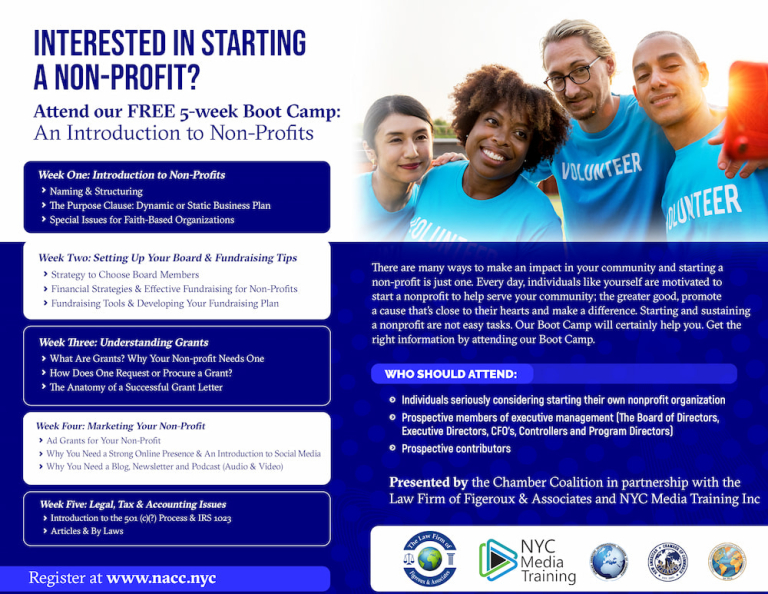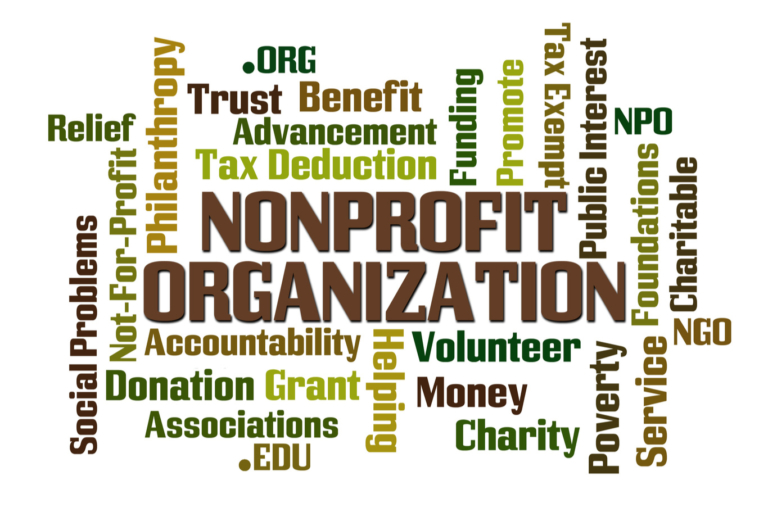Steps to Starting Your Non-Profit

Starting a nonprofit is no different from starting any other business. You must research, write a business plan, and file business-formation documents with your state. However, nonprofits face one additional hurdle—they must get approval from the Internal Revenue Service (IRS) to be exempt from taxes.
This guide will help you learn how to start a nonprofit organization and include tips for creating a nonprofit business plan to start on solid legal and financial footing:
1. Conduct a needs assessment.
You might have a great nonprofit idea, but more than an idea is needed to build a foundation for a charitable organization. Some preliminary research also needs to happen to determine if your idea is viable.
Think of it this way: a successful nonprofit fills a unique need. A needs assessment helps you identify that need, determine what other organizations are already doing, and research the best solutions.

To conduct a needs assessment:
Visit the U.S. Census Bureau website for basic demographic information for your area.
Talk to people at other nonprofits or businesses that have related missions. If another entity already provides the service you want, consider revising your mission or collaborating with that organization.
Interview people who might need your nonprofit’s services to discover their obstacles.
Research logistics and practicalities, including federal, state, and local laws.
Learn about similar programs in other communities.
Use this research to write a needs assessment describing your nonprofit’s mission, strengths, weaknesses, and the need it will fill.
Remember, the main questions you’re trying to answer are: what is the problem, and how can my organization fix it? New nonprofits that take time to fully understand the needs they’re trying to—and can—meet may be better positioned for success when it’s time to launch.
2. Complete a market analysis.
It would only make sense to start a for-profit company after doing market research; the same principle applies to starting a nonprofit.
After all, organizations, including nonprofits, must bring in money to survive. That’s why a market analysis—a plan for getting financial and volunteer support for your nonprofit—is necessary.
Market research and analysis can help you to:
- • Clarify who you would like to receive support from
- • Compare your charitable organization with others that serve a similar need and audience.
- • Refine your brand messaging and organization’s mission statement.
- • You should better understand how your nonprofit’s financial situation may affect its ability to market and attract new donors or volunteers.
How do you conduct this analysis when starting a nonprofit?
You can begin by listing the kinds of supporters you want, such as donors or volunteers. For each type, envision an “ideal supporter” and write down some characteristics, such as:
- • Age
- • Income
- • Occupation
- • Lifestyle
- • Reasons for supporting you
Next, surveys and interviews will be used to reach out to potential donors to uncover their motivations for giving and the types of communications in which they respond best.
Use your research to fine-tune your ideal supporter descriptions. These descriptions will help you target your fundraising and outreach to the people most likely to be enthusiastic donors and volunteers for your cause.
Doing market research for a for-profit company typically means looking at the competition, which you can do. For example, if another charitable organization in your niche is striving, it may benefit you to analyze how they’re doing it.
The idea is not to compare but to understand:
- • Who are the most prominent donors?
- • What strategies or tactics is the existing nonprofit using to raise brand awareness?
- • How do the organization’s goals compare to or differ from yours?
It’s worth noting that you don’t have to do this alone. Many companies will conduct nonprofit market research analysis for you in exchange for a fee. If your financial situation allows you to invest in something like that, it may be worth it, so you have more time to focus on the other key aspects of starting a nonprofit.

3. Choose from the three types of non-profit organization structures.
Choosing the right type of nonprofit structure is an integral part of forming your nonprofit. The most common types of business structures include:
- • Corporations
- • Associations
- • LLCs
For these structures to be recognized as tax-exempt by the IRS, they must qualify for 501(c)(3) status.
Section 501(c)(3) of the Internal Revenue Code applies federal tax-exempt status to the following entities:
- • Charitable organizations
- • Religious Organizations
- • Educational and scientific organizations
- • Literary organizations
- • Organizations that are focused on testing for safety
- • Organizations that foster national or international amateur sports competitions
- • Organizations that work toward the prevention of cruelty to children or animals
Federal law defines a charitable organization but gives organizers the freedom to choose which type of structure to pursue. A new nonprofit may be established as a corporation, association, or limited liability company.
Here’s how they compare.
Corporation: A nonprofit corporation is the most popular type of nonprofit organization. These types of nonprofits qualify as tax-exempt, are protected from liability, and can qualify for grants. A corporate structure could make it easier to attract donors, and you also benefit from state tax-exempt status.
Association: An unincorporated nonprofit association is when two or more people come together to benefit the public without filing legal paperwork or forming an official legal structure. If the primary purpose of an unincorporated association is charitable, it can qualify as a 501(c)(3) organization.
LLC: Forming a nonprofit LLC is similar to forming a corporation, but the organizational structure is more relaxed. Nonprofit LLCs can only be recognized as 501(c)(3) if all of their members are 501(c)(3) organizations.
There’s a fourth option as well, which is the fiscal sponsorship.
This arrangement can allow nonprofits to attract donors if they still need to qualify for federal tax-exempt status as a 501(c)(3) organization. A fiscal sponsor accepts charitable contributions on behalf of the nonprofit and provides fiduciary oversight to the organization.
Choosing a fiscal sponsorship can be an opportunity to test out your nonprofit idea and see what kind of demand exists for your service(s). You may also find it easier to outsource specific administrative tasks to a fiscal sponsor while you wait for your IRS determination letter. This letter affirms that your nonprofit meets the standards for tax-exempt status under federal law.
4. Create a business plan
A nonprofit business plan is similar to a for-profit one, but the fundraising section makes it different. The key elements you’ll want to include in your nonprofit business plan are:
Here’s how they compare.
Executive summary: This includes your mission statement and purpose, business goals, business values, and how you will meet the needs of your target audience.
Products, services, and programs include what services and programs you plan to offer.
Community impact: Think about how the programs and services you’re offering will impact the community and how you’ll measure your success.
Market and competitive analysis: Determine any gaps in your market, how your nonprofit will help fill those gaps, and your plan for getting support.
Organizational structure and staffing: This includes how your business will operate and what employee roles you must fulfill to execute day-to-day operations.
Marketing plan: This should include your target market (potential donors) and your plan for recruiting and getting people involved in your mission.
The financial plan includes how you plan to get funding—including grants and donations—to operate your nonprofit.
A well-written business plan is something most nonprofits can benefit from having. Similar to how a for-profit business might use its business plan to obtain loans or other types of financing, you might use your plan to attract individual and institutional donors.
Remember that as your organization grows, you may need to revisit and adjust your business plan. If your organization’s mission changes, for instance, or you decide to expand the scope of services you offer, you’d want to integrate those changes into your plan.

5. Secure funding.
When starting your nonprofit organization, you may need a hefty amount of funding upfront to cover startup costs and continuous financing to bring in revenue and help you sustain your organization.
When looking for funding options, grants, donations, and membership programs are among the most popular ways nonprofits generate operational funds.
Grants
Many different types of government grants are available to nonprofits to help with startup funding. These grants are available at the local, state, and federal levels, and the application process is often extensive.
Below are the steps you can take to secure a grant for your nonprofit:
- • Search for a grant that could be a good fit via Grants.gov
- • Review the grants requirements
- • Determine your eligibility
- • Fill out the application
- • Review the application requirements
- • Submit your application
- • Donations and fundraising
Donations can come in various ways, including corporate sponsorships, individual donations, and events.
Corporate sponsorships: These donations are made by more giant corporations interested in your nonprofit’s mission.
Individual donations: These are made on a one-time or recurring basis and are usually made online or in person at events.
Fundraising events: Events are a great way to generate funding and raise awareness for your organization.
Membership Programs
Part of keeping your nonprofit running is a membership program in which members can contribute money to your organization. This usually includes a membership fee—whether a one-time, yearly, or monthly payment—that can help with running costs.
These fees usually result in membership benefits, like free entry to fundraising events, access to a member newsletter, and discounts to local businesses. Membership organizations can be an effective way to raise funds while ensuring that donors remain engaged with your organization.
Nonprofits pursue fundraising through multiple avenues rather than limiting themselves to one option. Looking at how other charitable organizations in your niche are raising funds can give you a better idea of the most effective methods.
Ready to start your business?
What’s your business name?
Once you’ve built a solid foundation and have secured funding, it’s time to form your nonprofit business. When forming a nonprofit corporation, you’ll have to:
- • Choose a nonprofit
- • Set up a board of directors
- • File incorporation documents
- • Fill out the application
- • Create bylaws and operating rules
- • Get an employer identification number (EIN)
- • Obtain any licenses
Remember that most states have a unique business classification for nonprofit corporations. You must register in that state if you plan on receiving donations from another state. The National Association of State Charity Officials (NASCO) is an excellent resource for finding contact information for the state you’d like to register in.
Nonprofit incorporation or LLC: What’s the difference?
Part of forming your nonprofit is choosing your legal structure. In most cases, nonprofits are formed as corporations, but an LLC can also be a nonprofit. Both a nonprofit incorporation and a nonprofit LLC will serve the same purpose: serving a community.
Those forming a new nonprofit may be interested in an LLC structure because it can be more flexible with its organizational structure. On the other hand, a nonprofit corporation has more restrictions regarding shareholders, directors, and managers.
The most significant difference between forming a nonprofit incorporation and a nonprofit LLC is the requirements involved in the process.
Forming a nonprofit corporation includes all of the steps mentioned above. However, there are a few additional and more complicated steps when creating a nonprofit LLC, one of which is obtaining 501(c)(3) status so you can qualify for tax exemption.
For a nonprofit LLC to be recognized as tax-exempt, it must:
- Be owned by a sole member that is a 501(c)(3) organization
- Be owned by two or more members that are both organizations or
- File Form 1023 with the IRS to apply to be recognized as tax-exempt under section 501(c)(3)
It’s important to consult any state laws affecting the formation of a nonprofit corporation or LLC. For instance, state law may specify:
- • How many board members you must have on the board of directors if one is required in your organizational structure
- • The duties and responsibilities of the executive director, if you’re required to appoint one
- • How often board meetings must be held
- • When and how the details of board meetings must be disclosed to the public
It’s important to ensure your nonprofit complies with federal and state laws to avoid fines or other penalties.

7. Apply for tax-exempt status.
Once you’ve incorporated your nonprofit, you’ll want to apply for tax exemption with the IRS. Remember, you must have an employer identification number before submitting your application.
Each type of nonprofit organization has rules for tax-exempt eligibility, tax-deductibility of contributions, and whether the organization can lobby legislators or support candidates.
Most nonprofits are 501(c)(3) charitable organizations. Of those, most are public charities, including animal welfare organizations, food banks, and museums. Private foundations are also 501(c)(3) organizations.
Donations to 501(c)(3) organizations are tax-deductible, and income that fulfills their mission is tax exempted.
You must download, complete, and submit the appropriate IRS application to get tax-exempt status.
- • Form 1023 is for large nonprofits
- • Form 1023-EZ is for smaller organizations
After you file your nonprofit application, the IRS may have questions or need more information.
If everything is in order, receiving a determination letter granting tax-exempt status can still take several months.
Those forming a new nonprofit may be interested in an LLC structure because it can be more flexible with its organizational structure. On the other hand, a nonprofit corporation has more restrictions regarding shareholders, directors, and managers.
Once you receive your IRS determination letter, you can file for tax-exempt status in your state
Remember that you may also need to apply for sales tax exempt status or property tax exemptions separately from corporation registration. The requirements for state tax forms can vary based on your location.
The IRS requires 501(c)(3) organizations to pass a public support test to qualify as tax-exempt charities. The public support test measures how much a charitable organization’s donations come from public donors.
There are two standards used to test for public support. One is for charitable organizations described in sections 509(a)(1) and 170(b)(1)(A)(vi) of the Internal Revenue Code. The other is for organizations described in section 509(a)(2).
The 509(a)(1) test requires that a nonprofit organization receives at least one-third of its support from contributions from the general public or meets the 10% facts and circumstances test.
The 509(a)(2) test requires that the organization receive more than one-third of its support from contributions from the general public and gross receipts from activities related to its tax-exempt purposes.
Under the second test, nonprofits can receive only one-third of support from gross investment income and unrelated business taxable income.
- Keep your tax-exempt status—tips for maintaining your tax-exempt status as a nonprofit.
The final step in starting a nonprofit organization is maintaining your tax-exempt status. Here are the things you need to do to keep your tax-exempt status year-round:
Keep detailed records and documentation: You’ll need to record all donations, grants, and funding you’ve received, operational expenses, and all financial records. You’ll use these records to prove that your revenue is toward your intended purpose.
Stay compliant with bylaws: Nonprofit bylaws include all the guidelines and laws you must follow to operate your nonprofit. It’s important to ensure you’re always adhering to these laws and using them to make all important operational decisions to maintain your tax-exempt status.
File your annual tax forms: If your annual revenue is over $50,000, you must file Form 990, and if it is below $50,000, you must file Form 990-EZ.
Observe other annual reporting requirements. Your state may also require you to file additional paperwork to submit with your Form 990. You may also be required to periodically renew your state tax-exempt status or update your organization’s information.
The IRS can audit charities and nonprofits the same way they can for-profit businesses or individual taxpayers. That’s why keeping accurate records of your financial situation is so important. Some of the financial statements you should maintain include:
- • Statement of Activities (Income statement)
- • Statement of Financial Position (Balance sheet)
- • Statement of Functional Expenses
- • Statement of Cash Flow
If you still need to establish a separate bank account for your nonprofit, you’ll need to do that. Some banks offer nonprofit banking packages that operate similarly to business bank accounts.
Using accounting software for nonprofits that integrates with your bank account can make generating the necessary financial statements for your organization easier.
Ready to start your business?
What’s your business name?
Starting a nonprofit FAQ
Can anyone start a nonprofit?
Starting a nonprofit requires dedication, commitment, time, and financial resources. It also helps to have some local expertise for the needs that you’re trying to meet. However, no rule says you must have a certain degree or professional background to start a nonprofit.
If you’re considering starting a nonprofit, it’s important to be realistic about the process and how committed you are to furthering your cause. Resilience and determination are important qualities, as most nonprofits encounter some initial bumps.

How do I start a nonprofit organization with no money?
If you’re trying to start a nonprofit organization with no money, government grants and loans may be available to help with startup costs. Fiscal sponsorships are another great way to get your nonprofit up and running.
Fiscal sponsorships can be formed when community organizations or nonprofits partner with new organizations. Through this partnership, you can receive help attracting donors and securing funding before your nonprofit is recognized as a 501(c)(3) by the IRS. Aside from funding, a fiscal sponsor can help guide you through starting your nonprofit and help tackle administrative tasks.
How do nonprofit owners make money?
Nonprofits receive revenue through grants, donations, and membership programs. They then use this revenue to pay for expenses needed to operate their business, including employee salaries and compensation.
Nonprofit owners pay themselves (and their employees) a fair salary from their revenue, as it is an operating business expense.
Can you start a nonprofit alone?
The short answer is yes—you can start a nonprofit organization alone. However, much time and effort are involved in the startup process, and having support from a partner or team can help make things run more smoothly. You’ll also need to form your board of directors involved in critical decision-making, eventually needing a team by your side.
If you have questions about how to start a nonprofit, some resources can help. For instance, the National Council of Nonprofits provides information and guidance on starting a nonprofit. Talking to an experienced attorney can also help you clarify what’s involved in the process.
What is the easiest nonprofit to start?
The easiest type of nonprofit to start is one that has low startup costs and can easily attract donors or volunteers to support your mission. Ideally, it also aligns with a need you hope to fill in your community. Examples of simple charitable organizations to start include literary organizations or a community garden that encourages hands-on participation.

Is it better to start a nonprofit or for-profit?
Nonprofit organizations and for-profit businesses are two different wheelhouses. Simply put, a for-profit business’s primary purpose is to make a profit, while the purpose of a nonprofit is to use its profits to give back to a community and further its mission. Because of this, nonprofits are exempt from paying taxes, and for-profit businesses must pay taxes by law.
Choosing between the two all comes down to your business goals.
If your main goal is to earn money by selling products or services, a for-profit business may be right for you.
If your main goal is to have a charitable business that gives back to the community, a nonprofit business may be for you.
Start your nonprofit today.
Setting up a nonprofit can be complicated and time-consuming, but consulting a lawyer who has experience with nonprofits can help the process go smoothly. A lawyer can answer questions, prepare articles of incorporation, and review your application to the IRS. They can also explain your ongoing obligations so you can maintain your tax-exempt status and run a successful nonprofit organization.
Building Your Non Profit Board of Directors

One of the fundamental tasks facing the founders of any Nonprofit establishing a board of directors to oversee the organization. The board plays an essential legal and practical role in any nonprofit, even if others (such as an executive director, paid staff, or volunteers) handle the organization’s everyday affairs. Here are some important pointers:
1. Be sure you are building a board with the right task in mind. Boards have multiple roles, from fundraising to caretaking, governance, and oversight. Just like any company or corporation, it is important to do an assessment. Understand the skills that your particular non-profit needs to fulfill your mission.
2. Choose people who understand your mission and who understand the value they bring is beyond their checkbook.
3. Don’t overload the board with names. Choose a manageable number of individuals that will be genuinely active and contribute in a concrete manner. Not every person who donates money, even sizable amounts, should automatically be given a seat at the board table. Creating an advisory group or some other way to honor and engage people is useful.
4. Make sure there is financial acumen built into the board. Ensure there are people who understand the audit committee, as this is vital for keeping track of an organization’s performance and integrity. Separately, financial planning and strategic planning are critical to a non-profit’s current and long-term health.
6. Have at least one genuinely independent member. It is helpful to have some people in the room who are neither donors nor beneficiaries and bring true independence to the discussion and oversight role of the board.
7. Make sure people are coming to the board for the right reasons. Belief in the cause and a genuine interest in helping build a strong organization to address the non-profits cause. The individual’s commitment to the organization, not reputation should be deciding factor. By the same token, you want to make sure your objectives are in alignment and that both parties feel assured that their activities won’t taint one another.
8. Identify a mix of individuals that have previously served on boards who will come in with experience with the boardroom with those who are new to the boardroom. Mixing those with experience with those who have not served on a board can marry best practice with enthusiasm and a desire to learn and contribute to the board.
The Board's Role

Nonprofits receive favorable tax treatment and other benefits precisely because they are created to serve the public interest. And the nonprofit’s board shoulders the legal duty to keep the organization true to its public service mission, so that it continues to deserve its tax-favored status. (This “public trust” role explains why nonprofit directors are sometimes called trustees.)
In addition to setting policies and maintaining the nonprofit’s overall direction, a good board also serves an immensely practical role. The board of directors:
- Defines the nonprofit’s mission
- Establishes priorities
- Crafts strategies
- Ensures that plans and programs are implemented.
Without a committed board to tackle these tasks, a nonprofit can quickly run adrift, without clear goals or any specific plans to achieve them.
Board members are also involved in a nonprofit’s fundraising efforts. You should be able to count on your board members to spread the word about your good work, use their connections to gain access to potential donors, actively participate in fundraising campaigns, and — when financially feasible — make their own donations. Whether a board member is more comfortable working behind the scenes or asking for money directly, there should be a way for the whole board to get involved.
Nonprofit board members often go beyond the traditional directorial tasks of setting policy and defining a nonprofit’s goals. Especially in small all-volunteer nonprofits (and even in those with a small paid staff), board members often roll up their sleeves and do much of the nonprofit’s actual work, be it feeding the hungry, helping the unemployed, or cleaning the forests.

What Makes a Good Board
Most great boards share some common traits and qualities that enable them to lead their groups creatively and effectively. The members of an ideal board of directors:
share a passion for and commitment to the nonprofit’s mission are willing to roll up their sleeves when necessary to help with the practical work have strong ties to their communities are diverse — in age, gender, race, religion, occupation, skills, and background, and are willing to support efforts to raise money.
How Board Members Are Different From Staff
Generally speaking, the board is not in charge of the day-to-day affairs of the nonprofit. Taking care of the many details involved in running the organization is the responsibility of the nonprofit’s staff, including the executive director, paid workers, and volunteers.
Of course, many nonprofits – especially new and small ones — are run almost entirely by the board and other volunteers. Plenty of micro-nonprofits operate this way, which can make the distinction between the board role and the staff role quite confusing. But it’s key to understand that the same person may sometimes play a board member’s role, and sometimes an activist or volunteer staff role. Board members should be clear on this: Although they may take care of all the nonprofit’s day-to-day details, they are not doing so in their capacity as board members.
Some examples of a board member wearing a “staff hat” –not a “board hat” — include:
• Donning galoshes to help with a Clean Up the Wetlands day
• Stuffing envelopes
• Picking up chairs for an event
• Teaching a seminar
On the other hand, when a board member is discussing whether certain programs fit into the nonprofit’s overall mission, that member is wearing a “board hat.” Keeping this distinction in mind will help you understand the board/staff relationship and the breakdown of roles that is so important to the effective functioning of a nonprofit.


Recruiting Board Members
Most new nonprofits appoint their very first board members as part of the process of incorporating. Nonprofit corporations (and for-profit ones, too) are created at the state level, most commonly by filing papers known as articles of incorporation with the secretary of state’s office. Those articles generally ask for the names of the nonprofit’s initial board of directors. If your state requires a minimum number of directors (many do and three is a common minimum), you’ll need to name at least that many in your articles.
In established nonprofits, appointing board members is generally a more formal process. Often, a nominating committee of existing board members evaluates the current board situation and its needs, gathers names of prospective new members, and recommends candidates to the full board, which then votes on whether to elect the new members. In nonprofits that give members the legal right to elect directors, the members vote, rather than the board.
The Role of Committees
For larger boards, consider breaking down the board’s governance duties into smaller committees. Some may be permanent (sometimes called “standing”) committees to handle ongoing issues such as finance, program development, membership, or the like. Other issues that come up can be handled by creating a special (sometimes called “ad hoc”) committee. Don’t worry about what they’re called; just keep in mind that nonprofits typically use both kinds of committees to handle regular needs and new issues as they arise. Committees help maximize the board’s productivity in several ways.
Helping the board handle complex issues. The smaller committee can research and break down complex issues and present its findings to the board, which can then move forward to making decisions.
Matching board members with particular expertise to appropriate areas. Forming a committee is a great way to assign specific responsibilities to the people best able to handle them.
Engaging with issues more deeply and consistently than the board as a whole could. The finance committee, for instance, can and should maintain thorough and ongoing management of the nonprofit’s finances between meetings, so that the whole board can deal with this key concern (based on the reports of the finance committee) at board meetings.
Dividing the board’s workload. Having separate committees is a simple way to distribute responsibility for the many tasks boards typically need to tackle.
Attracting and involving newcomers. In some nonprofits, specialized committees often include people who aren’t on the board of directors (a nonprofit that promotes physical fitness for diabetic children might have a doctor on one of its program committees, for example).
Serving as a training ground for new board members. Chairing or just being involved in a committee is a good way for inexperienced board members to increase their involvement, develop confidence, and learn leadership skills.
Analysis of Factors to Consider When Building a Website for a Non-Profit Organization

Creating an effective website for a non-profit organization involves a strategic approach to ensure it meets its goals and effectively engages the target audience. Below is a detailed analysis of the critical factors to consider when building such a website, divided into key sections for clarity.
1. Purpose and Goals of the Website
The first step in building a website for a non-profit organization is clearly defining its purpose and goals. These could range from raising awareness, recruiting volunteers, securing donations, and providing information about services or advocacy efforts. Understanding the primary objectives will shape every decision in the website development process.
– Awareness and Outreach: Highlighting the mission and impact stories.
– Volunteer Recruitment: Showcasing volunteer opportunities and testimonials.
– Donations: Simplify the donation process and demonstrate the impact of contributions.
– Information Dissemination: Providing comprehensive information about the organization’s services and initiatives.
2. Audience Analysis
Identifying and understanding the target audience is crucial for a non-profit website. This includes donors, volunteers, beneficiaries, and the general public. Each audience segment may have different needs and behaviors online.
– Donors: Interested in transparency, financial accountability, and the impact of their contributions.
– Volunteers: They are looking for ways to get involved, understand the commitment required, and see the difference they can make.
– Beneficiaries: Seeking information on services, eligibility, and how to access support.
– General Public: Need to understand the organization’s mission and be inspired to support in various ways.

3. User Experience (UX) Design
User experience design ensures visitors can easily navigate the website and find the information they need.
– Navigation: Clear, intuitive navigation helps users find information quickly. Use a simple menu structure and ensure that important pages are easily accessible.
– Accessibility: Ensure the website is accessible to people with disabilities, adhering to WCAG (Web Content Accessibility Guidelines). This includes using alt text for images, providing video transcripts, and ensuring keyboard navigability.
– Mobile Responsiveness: Most web traffic comes from mobile devices. The website should be fully responsive, providing a seamless experience across all devices.
– Load Speed: Optimize images and other media to ensure the website loads quickly, as slow load times can deter visitors.
4. Content Strategy
Content is the heart of any website. For non-profits, creating content that resonates with the audience and drives engagement is essential.
– Mission and Vision Statements: Clearly articulate the organization’s mission and vision to convey its purpose immediately.
– Impact Stories: Use stories and testimonials to illustrate the tangible impact of the organization’s work.
– Calls to Action (CTAs): Strategically place CTAs throughout the site to encourage donations, volunteer sign-ups, and other forms of support.
– Blog and Updates: Regularly updated content, such as blog posts and news updates, can keep the audience engaged and informed about ongoing initiatives and successes.

5. SEO and Digital Marketing
Search engine optimization (SEO) and digital marketing are essential for increasing the website’s visibility and attracting more visitors.
– Keyword Research: Identify and use relevant keywords to improve search engine rankings.
– Meta Tags and Descriptions: Optimize meta tags and descriptions to improve click-through rates from search engine results.
– Backlinking: Establish relationships with other websites and organizations to generate backlinks, which can improve SEO.
– Social Media Integration: Integrate social media channels to enhance engagement and drive traffic to the website.
6. Donation and Fundraising Tools
A non-profit website should facilitate easy and secure donations. Implementing effective donation tools can significantly impact fundraising efforts.
– Donation Forms: Use user-friendly donation forms allowing one-time and recurring donations.
– Payment Processing: Ensure secure and varied payment processing options to accommodate different donors.
– Transparency: Provide clear information on how donations are used, which can enhance trust and encourage contributions.

7. Legal and Security Considerations
Ensuring the website is legally compliant and secure is crucial to protect the organization and its supporters.
– Privacy Policy: Include a comprehensive privacy policy to inform visitors how their data will be used.
– Data Protection: Implement strong data protection measures to safeguard donor and user information.
– SSL Certification: Secure the website with SSL certification to ensure encrypted data.
8. Technical Infrastructure
The website’s technical foundation should be robust and scalable to handle varying levels of traffic and content updates.
– Hosting: Choose reliable hosting services that offer good uptime and support.
– Content Management System (CMS): Use a CMS that is easy to manage and allows the non-profit’s team to update it regularly.
– Scalability: Ensure the website infrastructure can scale to accommodate future growth and increased traffic.

9. Analytics and Reporting
Tracking and analyzing website performance is essential for continuous improvement.
– Analytics Tools: Implement tools like Google Analytics to monitor traffic, user behavior, and conversion rates.
– Reporting: Regularly review analytics reports to understand what’s working and where improvements are needed.
10. Community and Engagement Features
Building a community around the non-profit can drive long-term engagement and support.
– Forums and Comment Sections: Enable discussions and interactions among supporters.
– Event Calendars: Provide information on upcoming events and opportunities for involvement.
Building a website for a non-profit organization requires a comprehensive approach that considers the organization’s goals, audience, user experience, content strategy, SEO, fundraising tools, legal and security aspects, technical infrastructure, analytics, and community engagement. By addressing these factors, a non-profit can create a powerful online presence that supports its mission and drives meaningful engagement and support.
Your Board Members' FAQ

One way to tell prospective board members what you expect is to create a “board candidate FAQ” that communicates all of the important facts in a simple, one-page question-and-answer format. Here are some examples of the types of questions that might be included in an FAQ for prospective board members (you’ll need to provide the answers to these questions):
- What is the organization’s mission statement?
- What is the organization’s history?
- What are the board members’ responsibilities?
- How long does a board member serve on the board?
- Are there any legal issues that board members should worry about?

Useful Links
Recent Posts
- How a Pre-Existing Condition Can Affect a Personal Injury Claim November 11, 2025
- Dental Injuries After a Car Accident: What You Need to Know October 28, 2025
- Partisan Politics Should Not Hurt People October 20, 2025
- 7 Reasons Why Your Business Needs a Corporate Lawyer October 20, 2025
Partner Organizations
Contact Info
Careers
Case Evaluation & Support
Disclaimer
This website contains general information about the Law Firm of Figeroux & Associates. This website is not intended to be a solicitation or to provide legal advice. It is intended to provide general information and is not an invitation to an attorney-client relationship. No reader of this website should take action or act or refrain from doing so on the basis of information provided herein.
